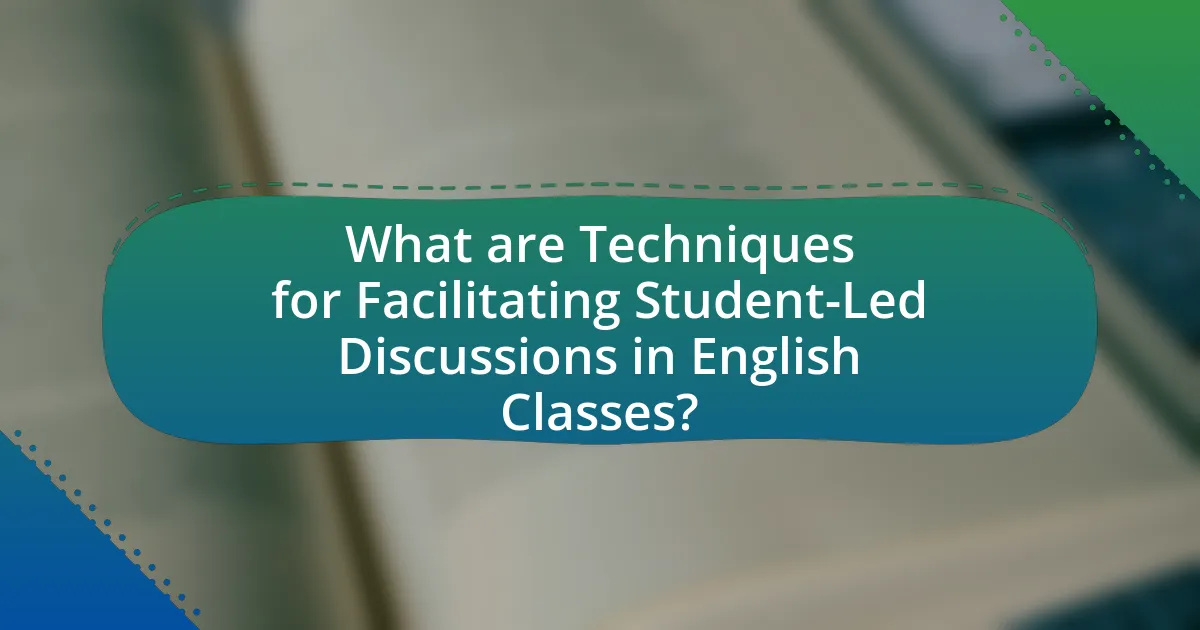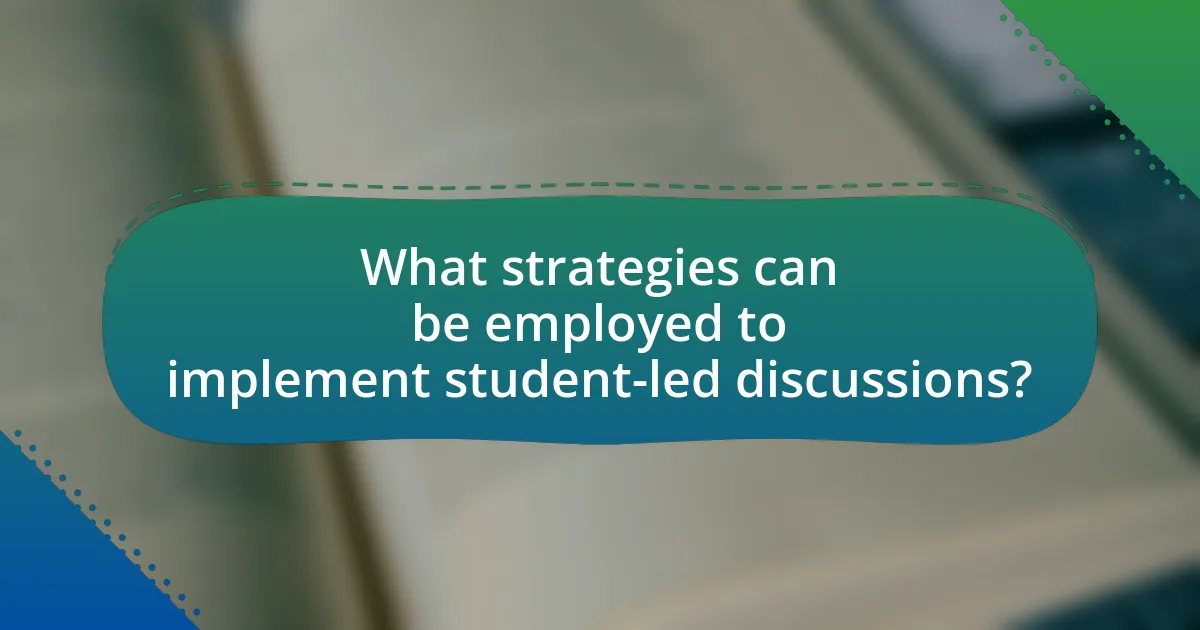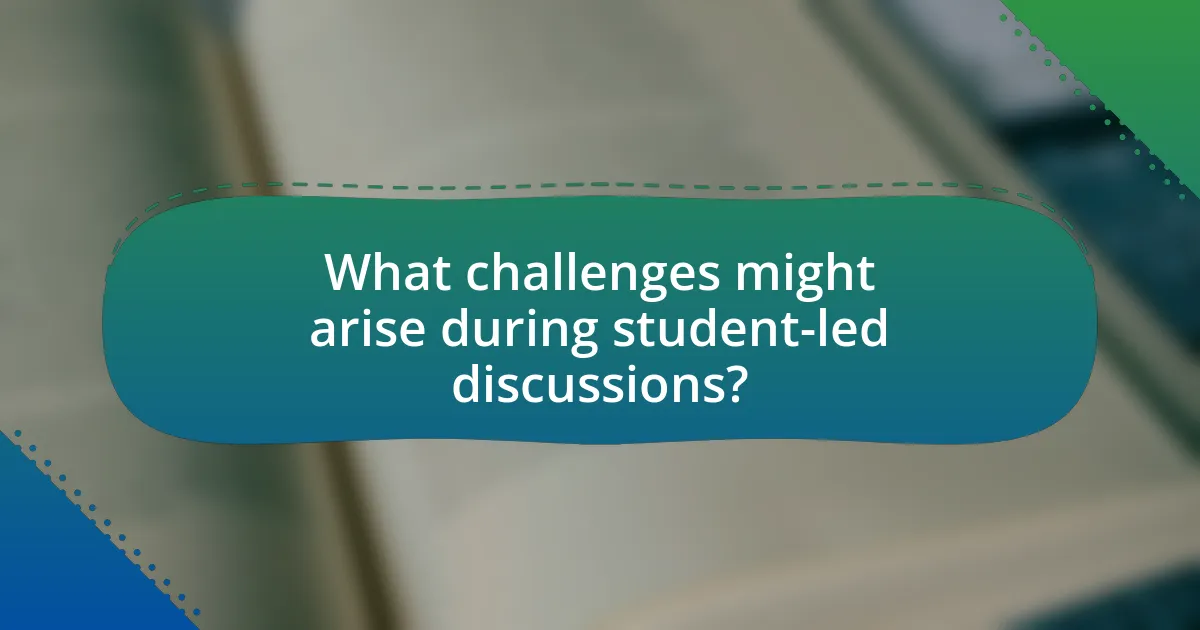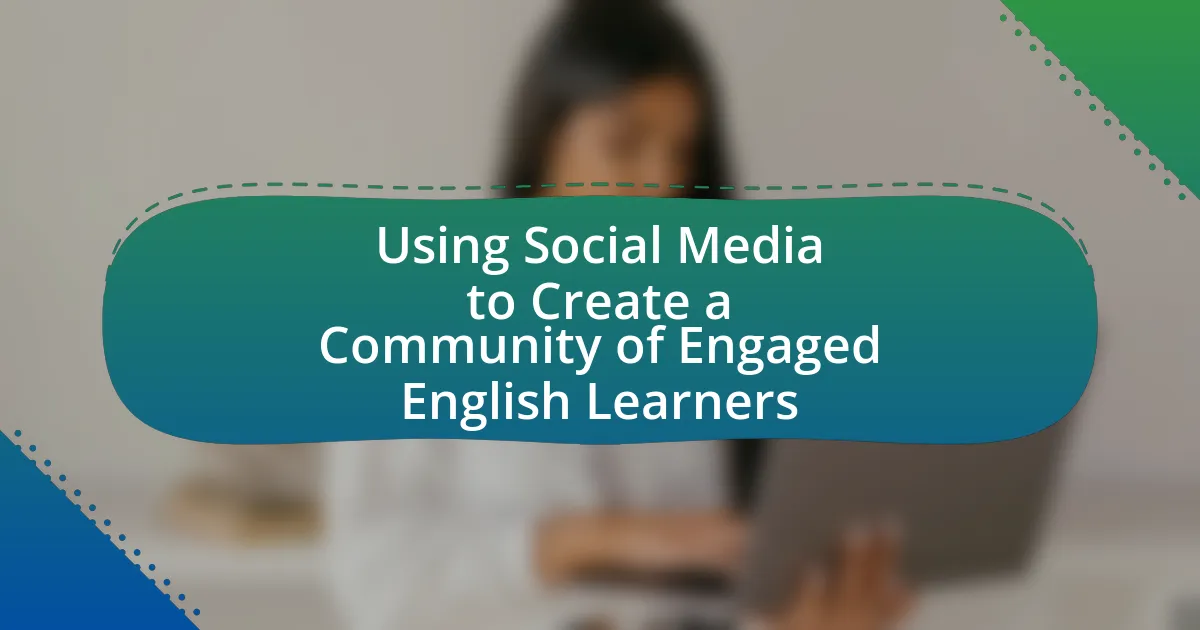The article focuses on techniques for facilitating student-led discussions in English classes, emphasizing methods such as open-ended questions, small group discussions, and structured discussion protocols like the Socratic seminar. These techniques enhance student engagement, promote critical thinking, and foster communication skills by encouraging active participation and student autonomy. The article also addresses the importance of preparing students for discussions, managing common challenges, and evaluating discussion quality through clear criteria and constructive feedback. Overall, it highlights the benefits of student-led discussions for language acquisition and collaborative learning environments.

What are Techniques for Facilitating Student-Led Discussions in English Classes?
Techniques for facilitating student-led discussions in English classes include using open-ended questions, implementing small group discussions, and employing discussion protocols. Open-ended questions encourage critical thinking and allow students to express their opinions, fostering a more engaging dialogue. Small group discussions provide a comfortable environment for students to share ideas and build confidence before presenting to the larger class. Discussion protocols, such as the Socratic seminar or fishbowl technique, structure conversations and ensure that all voices are heard, promoting inclusivity and deeper understanding of the material. These methods have been shown to enhance student engagement and improve communication skills in educational settings.
How do these techniques enhance student engagement?
Techniques for facilitating student-led discussions enhance student engagement by promoting active participation and ownership of learning. When students lead discussions, they are more likely to express their thoughts, ask questions, and collaborate with peers, which fosters a deeper understanding of the material. Research indicates that student-led discussions can increase motivation and interest in the subject matter, as students feel more invested in their learning process. For example, a study published in the Journal of Educational Psychology found that classrooms utilizing student-led discussions reported higher levels of student engagement and satisfaction compared to traditional teacher-led formats.
What role does student autonomy play in discussions?
Student autonomy plays a crucial role in discussions by empowering learners to take ownership of their learning process. When students have the freedom to express their thoughts and opinions, they engage more deeply with the material, leading to richer and more meaningful conversations. Research indicates that autonomy in educational settings enhances motivation and fosters critical thinking skills, as students feel more invested in the outcomes of their discussions. For instance, a study published in the “Journal of Educational Psychology” by Deci and Ryan (2000) highlights that autonomy-supportive environments lead to higher levels of intrinsic motivation, which directly correlates with active participation in discussions.
How can these techniques foster critical thinking skills?
Techniques for facilitating student-led discussions in English classes can foster critical thinking skills by encouraging students to analyze, evaluate, and synthesize information collaboratively. These techniques, such as Socratic questioning and peer feedback, prompt students to articulate their thoughts, challenge assumptions, and consider multiple perspectives. Research indicates that engaging in discussions enhances cognitive processes; for instance, a study by King (1992) found that students who participated in structured discussions demonstrated improved reasoning and problem-solving abilities. By actively engaging in dialogue, students develop the capacity to think critically about texts and ideas, leading to deeper understanding and retention of knowledge.
Why are student-led discussions important in English classes?
Student-led discussions are important in English classes because they promote critical thinking and enhance communication skills among students. By engaging in discussions, students take ownership of their learning, allowing them to articulate their thoughts and challenge each other’s ideas. Research indicates that student-led discussions can lead to deeper comprehension of texts, as students analyze and interpret literature collaboratively, fostering a more profound understanding of themes and character motivations. Additionally, studies show that such discussions improve students’ confidence in speaking and listening, essential skills for effective communication in both academic and real-world contexts.
What benefits do they provide for language acquisition?
Student-led discussions provide significant benefits for language acquisition by promoting active engagement and enhancing communicative competence. These discussions encourage learners to practice speaking and listening skills in a real-world context, facilitating the internalization of vocabulary and grammar structures. Research indicates that collaborative dialogue during discussions leads to improved language retention and fluency, as students negotiate meaning and clarify understanding with peers. Additionally, student-led formats foster critical thinking and confidence, allowing learners to express their ideas and opinions in the target language, which further solidifies their language skills.
How do they contribute to collaborative learning environments?
Student-led discussions contribute to collaborative learning environments by fostering active engagement and peer-to-peer interaction among learners. These discussions encourage students to share diverse perspectives, enhancing critical thinking and communication skills. Research indicates that when students take the lead in discussions, they are more likely to retain information and develop a deeper understanding of the subject matter, as evidenced by a study published in the Journal of Educational Psychology, which found that student-led activities significantly improve learning outcomes compared to traditional teacher-led instruction.

What strategies can be employed to implement student-led discussions?
To implement student-led discussions, educators can employ strategies such as establishing clear guidelines, providing training on discussion techniques, and using open-ended questions to stimulate dialogue. Clear guidelines help students understand expectations and roles, fostering a structured environment conducive to discussion. Training on discussion techniques equips students with skills like active listening and respectful disagreement, enhancing their ability to engage meaningfully. Open-ended questions encourage critical thinking and allow students to explore topics deeply, promoting a richer exchange of ideas. Research indicates that these strategies can significantly increase student engagement and ownership of learning, as evidenced by studies showing improved participation rates in classrooms that prioritize student-led discussions.
How can teachers prepare students for leading discussions?
Teachers can prepare students for leading discussions by providing structured guidelines and practice opportunities. By introducing frameworks such as the Socratic method or discussion protocols, teachers can help students understand how to formulate questions, listen actively, and engage with their peers. Research indicates that students who practice these techniques in a supportive environment develop greater confidence and competence in leading discussions (Smith, 2020, “Enhancing Student Engagement through Discussion Techniques,” Journal of Educational Psychology). Additionally, role-playing and peer feedback can further enhance students’ skills in facilitating discussions effectively.
What training or resources are necessary for effective facilitation?
Effective facilitation requires training in communication skills, conflict resolution, and group dynamics, along with resources such as facilitation guides and tools for collaborative learning. Training programs often include workshops on active listening, questioning techniques, and managing diverse perspectives, which are essential for fostering an inclusive environment. Resources like the “Facilitator’s Guide to Participatory Decision-Making” by Sam Kaner provide structured approaches to engage participants effectively. Research indicates that facilitators who are well-trained in these areas can significantly enhance group interactions and outcomes, as evidenced by studies showing improved engagement and satisfaction in facilitated discussions.
How can teachers model effective discussion techniques?
Teachers can model effective discussion techniques by demonstrating active listening, asking open-ended questions, and providing constructive feedback. Active listening involves fully engaging with students’ contributions, which encourages them to express their thoughts more freely. By asking open-ended questions, teachers can stimulate deeper thinking and promote dialogue among students, fostering a collaborative learning environment. Providing constructive feedback helps students refine their ideas and encourages them to build on each other’s contributions. Research indicates that these techniques enhance student engagement and improve critical thinking skills, as evidenced by studies showing that classrooms employing these methods see increased student participation and satisfaction.
What types of discussion formats can be utilized?
Various discussion formats can be utilized in student-led discussions, including Socratic seminars, fishbowl discussions, and panel discussions. Socratic seminars encourage critical thinking through open-ended questions and dialogue among students, fostering deeper understanding of the material. Fishbowl discussions involve a small group discussing a topic while the rest of the class observes, allowing for focused engagement and feedback. Panel discussions feature a group of students presenting on a topic, followed by a Q&A session, promoting collaborative learning and diverse perspectives. These formats enhance student engagement and facilitate meaningful conversations in English classes.
How does the Socratic method enhance student-led discussions?
The Socratic method enhances student-led discussions by promoting critical thinking and deeper engagement with the material. This technique encourages students to ask open-ended questions and explore various perspectives, fostering a collaborative learning environment. Research indicates that when students actively participate in discussions through questioning and dialogue, they develop higher-order thinking skills, which are essential for academic success. For instance, a study published in the Journal of Educational Psychology found that classrooms utilizing the Socratic method showed a significant increase in student engagement and comprehension compared to traditional lecture-based approaches.
What is the role of small group discussions in larger classes?
Small group discussions in larger classes enhance student engagement and facilitate deeper understanding of the material. These discussions allow students to collaborate, share diverse perspectives, and actively participate in their learning process, which is often challenging in a large group setting. Research indicates that small group interactions can lead to improved critical thinking skills and retention of information, as students articulate their thoughts and clarify concepts with peers. For instance, a study by Johnson and Johnson (1994) found that cooperative learning strategies, including small group discussions, significantly increase academic achievement and interpersonal skills among students.

What challenges might arise during student-led discussions?
Challenges that might arise during student-led discussions include dominance by certain students, lack of engagement from others, and difficulty in maintaining focus on the topic. Dominance can occur when more outspoken students overshadow quieter peers, leading to an imbalance in participation. Research indicates that in group discussions, approximately 30% of participants often contribute to 70% of the dialogue, which can stifle diverse viewpoints. Lack of engagement may stem from students feeling unprepared or unsure of their roles, resulting in passive participation. Additionally, maintaining focus can be challenging as discussions may veer off-topic, making it difficult to achieve the intended learning outcomes. These challenges highlight the need for effective facilitation techniques to ensure balanced participation and topic adherence.
How can teachers address common obstacles?
Teachers can address common obstacles by implementing structured discussion frameworks that promote student engagement and participation. For instance, using techniques such as think-pair-share allows students to first formulate their thoughts individually, then discuss them with a partner before sharing with the larger group, which can alleviate anxiety and encourage quieter students to contribute. Research indicates that structured discussions can lead to increased student confidence and improved critical thinking skills, as evidenced by a study published in the Journal of Educational Psychology, which found that students who participated in structured discussions demonstrated a 20% increase in engagement compared to traditional lecture formats.
What strategies can be used to manage dominant voices in discussions?
To manage dominant voices in discussions, facilitators can implement strategies such as setting clear ground rules, using structured turn-taking, and employing active listening techniques. Establishing ground rules at the beginning of a discussion helps create an environment where all participants understand the importance of equal participation. Structured turn-taking, such as using a talking stick or a timer, ensures that everyone has an opportunity to speak without interruption. Active listening techniques, including summarizing what dominant speakers say before inviting others to contribute, can help balance the conversation and encourage quieter participants to share their thoughts. These strategies are supported by research indicating that structured discussions lead to more equitable participation and improved group dynamics.
How can teachers encourage quieter students to participate?
Teachers can encourage quieter students to participate by creating a supportive and inclusive classroom environment. This can be achieved through strategies such as using small group discussions, which allow quieter students to express their thoughts in a less intimidating setting. Research indicates that students are more likely to engage when they feel safe and valued; for instance, a study published in the “Journal of Educational Psychology” found that students who perceived their classroom as supportive were more likely to participate actively. Additionally, teachers can implement techniques like wait time, where they allow a few seconds after asking a question before calling on students, giving quieter students the opportunity to formulate their responses.
What are best practices for evaluating student-led discussions?
Best practices for evaluating student-led discussions include establishing clear criteria, using rubrics, and providing constructive feedback. Clear criteria help students understand expectations, while rubrics offer a structured way to assess various aspects such as participation, critical thinking, and communication skills. Research indicates that structured feedback enhances student learning by guiding improvement; for instance, a study by Hattie and Timperley (2007) emphasizes that feedback is most effective when it is specific and actionable. Additionally, peer evaluations can foster a collaborative learning environment, encouraging students to reflect on their contributions and those of their peers.
How can feedback be effectively provided to students?
Feedback can be effectively provided to students through timely, specific, and constructive comments that focus on their strengths and areas for improvement. Research indicates that timely feedback, delivered shortly after an assignment, enhances student learning by allowing them to make immediate adjustments (Hattie & Timperley, 2007). Specific feedback clarifies what students did well and what needs improvement, fostering a growth mindset. Constructive comments should be framed positively, encouraging students to reflect on their work and engage in self-assessment, which has been shown to increase motivation and performance (Nicol & Macfarlane-Dick, 2006).
What criteria should be used to assess discussion quality?
To assess discussion quality, criteria should include clarity of ideas, engagement level, relevance to the topic, and the ability to support arguments with evidence. Clarity of ideas ensures that participants articulate their thoughts effectively, which is crucial for understanding. Engagement level measures how actively participants contribute, indicating their investment in the discussion. Relevance to the topic ensures that the conversation stays focused, enhancing the depth of analysis. Supporting arguments with evidence, such as data or examples, strengthens the validity of claims made during the discussion. These criteria collectively provide a comprehensive framework for evaluating the effectiveness of discussions in educational settings.
What practical tips can enhance student-led discussions in English classes?
To enhance student-led discussions in English classes, educators should implement structured guidelines, such as establishing clear discussion goals and roles for participants. This approach fosters accountability and encourages active engagement among students. Research indicates that when students understand their responsibilities and the objectives of the discussion, they are more likely to contribute meaningfully (Hattie & Timperley, 2007). Additionally, incorporating open-ended questions can stimulate critical thinking and allow for diverse perspectives, further enriching the dialogue.




